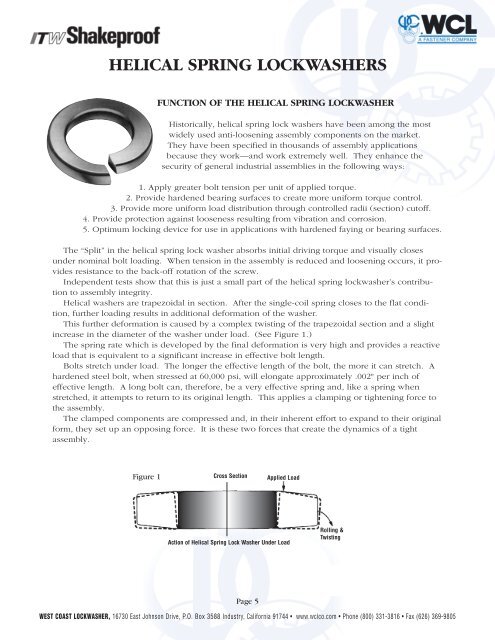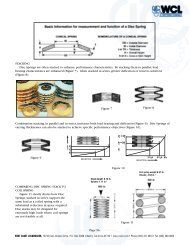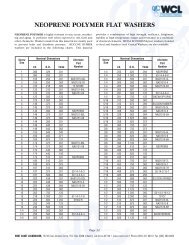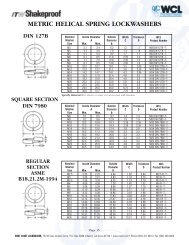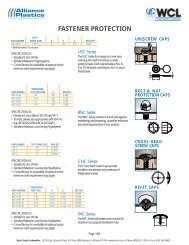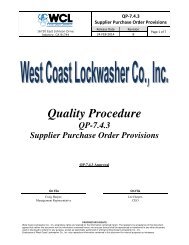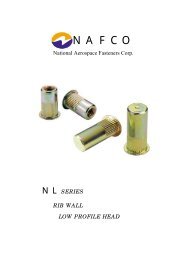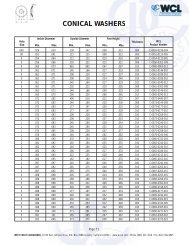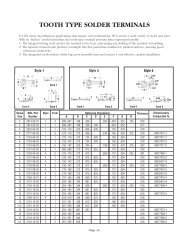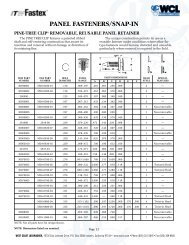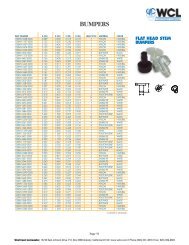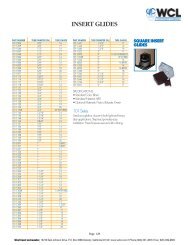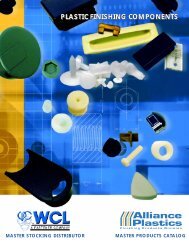Helical Spring Lockwasher (Page 1) - WCL Fasteners
Helical Spring Lockwasher (Page 1) - WCL Fasteners
Helical Spring Lockwasher (Page 1) - WCL Fasteners
Create successful ePaper yourself
Turn your PDF publications into a flip-book with our unique Google optimized e-Paper software.
HELICAL SPRING LOCKWASHERSFUNCTION OF THE HELICAL SPRING LOCKWASHERHistorically, helical spring lock washers have been among the mostwidely used anti-loosening assembly components on the market.They have been specified in thousands of assembly applicationsbecause they work—and work extremely well. They enhance thesecurity of general industrial assemblies in the following ways:1. Apply greater bolt tension per unit of applied torque.2. Provide hardened bearing surfaces to create more uniform torque control.3. Provide more uniform load distribution through controlled radii (section) cutoff.4. Provide protection against looseness resulting from vibration and corrosion.5. Optimum locking device for use in applications with hardened faying or bearing surfaces.The “Split” in the helical spring lock washer absorbs initial driving torque and visually closesunder nominal bolt loading. When tension in the assembly is reduced and loosening occurs, it providesresistance to the back-off rotation of the screw.Independent tests show that this is just a small part of the helical spring lockwasher’s contributionto assembly integrity.<strong>Helical</strong> washers are trapezoidal in section. After the single-coil spring closes to the flat condition,further loading results in additional deformation of the washer.This further deformation is caused by a complex twisting of the trapezoidal section and a slightincrease in the diameter of the washer under load. (See Figure 1.)The spring rate which is developed by the final deformation is very high and provides a reactiveload that is equivalent to a significant increase in effective bolt length.Bolts stretch under load. The longer the effective length of the bolt, the more it can stretch. Ahardened steel bolt, when stressed at 60,000 psi, will elongate approximately .002" per inch ofeffective length. A long bolt can, therefore, be a very effective spring and, like a spring whenstretched, it attempts to return to its original length. This applies a clamping or tightening force tothe assembly.The clamped components are compressed and, in their inherent effort to expand to their originalform, they set up an opposing force. It is these two forces that create the dynamics of a tightassembly.Figure 1 Cross Section Applied LoadAction of <strong>Helical</strong> <strong>Spring</strong> Lock Washer Under LoadRolling &Twisting<strong>Page</strong> 5WEST COAST LOCKWASHER, 16730 East Johnson Drive, P.O. Box 3588 Industry, California 91744 • www.wclco.com • Phone (800) 331-3816 • Fax (626) 369-9805
SPRING RATETwo terms are used to define and measure these described forces. One is <strong>Spring</strong> Rate. The other isequivalent bolt length.<strong>Spring</strong> Rate is the ratio of load to deflection in the loaded part; it is deflection related to load and isexpressed in terms of the amount of load required to achieve specific levels of deflection. The optimum jointperformance is obtained when the spring elements in the fastening system have a spring rate which is lowenough to assure that any yielding of the joint members in compression will not significantly reduce thedesigned tensile stress in the fastener. To obtain this optimal condition, the conventional solution is to utilizethe spring characteristics of very long bolts. An auxiliary spring element, such as helical spring lock washer,is a very effective alternative.Tests run by Lawrence Technological University have shown that the typical helical spring lock washerexhibits a spring rate after flattening which is approximately 70% more effective than a flat washer of thesame thickness.What this means to the design engineer is that the effective bolt length in the joint is increased by thethickness of the flattened helical spring lock washer, plus the equivalent length provided by the spring ratederived from the visually flattened washer. Tested at 75% of the hardened bolt proof load, the equivalentbolt length is as shown in figure 2.Figure 2EQUIVALENT BOLT LENGTHEquivalent Bolt Length (Inches)Washer<strong>Helical</strong>Size Lock Washers(Inches) Regular Heavy3/8 0.656 0.7417/16 0.686 0.7221/2 0.730 0.803The total contribution of a helical spring lock washer to the integrity of an assembly, in addition to the commonlyrecognized frictional resistance to back-off rotation, includes the reactive length added to the bolt bythe washer thickness and by the tension of <strong>Spring</strong> Rate generated by its compression.The significant contribution of the helical spring lock washer to the overall tightness of an assembly is bestshown in the test results for an assembly without a washer and an assembly that includes a helical springwasher.Generated <strong>Spring</strong> Rates Expressed in Equivalent Bolt LengthsThickness ofEquivalent Bolt Length to Attain ComparableAssembled Components<strong>Spring</strong> Rate of Components Under LoadJOINT WITHOUT WASHERBolt head height 0.24" Half of head height (deflected) 0.12"2 Assembled 1/8" plates 0.25" Total thickness of assembled plates 0.25"Nut thickness 0.32" Half of nut thickness (deflected) 0.16"Total thickness 0.81" Equivalent bolt length 0.53"JOINT WITH 3/8" DIAMETER HELICAL SPRING LOCKWASHERBolt head height 0.24" Half of head height (deflected) 0.120"2 Assembled 1/8" plates 0.25" Total thickness of assembled plates 0.250"<strong>Helical</strong> washer thickness 0.10" Total thickness of washer 0.100"Additional spring rate contributed by compressed washer 0.656"Nut thickness 0.32" Half of nut thickness (deflected) 0.160Total thickness 0.91" Equivalent bolt length 1.286"<strong>Page</strong> 6WEST COAST LOCKWASHER, 16730 East Johnson Drive, P.O. Box 3588 Industry, California 91744 • www.wclco.com • Phone (800) 331-3816 • Fax (626) 369-9805
GENERAL INFORMATIONSTANDARDS<strong>WCL</strong> helical spring lock washers qualify under the major standards requirements established by ASME (theAmerican Society of Mechanical Engineers) and DOD (Department of Defense) for components of this type.MILITARY SPECIFICATIONSMS35338-, MS35340-, MS51416-, MS51415-, MS51848-, MS122029 thru MS122036, NAS1640, NAS1676Also Ordnance series 12387272 - XX, 12387302 - XXAMERICAN SOCIETY OF MECHANICAL ENGINEERS:ASME B 18.13, ASME B 18.21.1, ASME B 18.21.2MMATERIALSCarbon Steel - SAE 1055 - 1065Boron Steel - 10B55 - 10B65Alloy Steel - SAE 4037Stainless Steel - SAE 304, SAE 316, SAE 420Aluminum Alloy - ASTM-B 211, 7075Phosphor Bronze - ASTM-B 159, Copper Alloy NO.510Silicon Bronze - ASTM-B 99, Copper Alloy NO.651 or 655Monel K500 - QQ - N - 286FINISHESWhen carbon steel helical spring washers are required for galvanizing, this must be indicated on the order orinquiry. ASME standards call for such washers to be coiled to limits 0.020" in excess of conventionalstandards. Galvanizing is not recommended for washers under a 1/4" nominal size.<strong>Helical</strong> washers are available in the following finishes:Mechanical ZincElectro ZincMechanical GalvanizedHot Dip Galvanized,Phosphate CoatingBlack OxideOther materials and finishes are available on special request. Mechanical Finish will limit exposure tohydrogen embrittlement unless otherwise specified.<strong>Page</strong> 7WEST COAST LOCKWASHER, 16730 East Johnson Drive, P.O. Box 3588 Industry, California 91744 • www.wclco.com • Phone (800) 331-3816 • Fax (626) 369-9805
HARDNESS TESTINGIn preparing a helical spring washer for hardness testing, it should first be twisted to remove the helix andform a near flat surface.Due to the trapezoidal cross section of the washer, both sides must be filed or ground flat to assure accuratereadings. This also removes decarburization and plating from the surface. Care must be taken to assurethat surface temperature does not exceed 250°F during this operation. (See figure 3.)An essential requirement of the Rockwell test is that the penetrator be perpendicular to the surface of thetest piece and that the test piece not move, in the slightest degree, as the test load is applied. One point ofhardness represents a depth of only 0.00008". A movement of only .001" could cause an error of over 10Rockwell numbers.Penetration should be made in the center of the washer’s flattened surface and readings should not betaken too close together. If the indentation is made too close to the edge of the test washer, the material willyield, giving incorrect low readings. Also, the area surroundingHARDNESSthe indent will be cold worked. Subsequent indentations, if madein the cold worked area, will give incorrect readings-usually higherthat the virgin material. Also, test penetrations should be made ononly one side of the washer.1. WASHER TO BE TESTEDThe thickness of the test sample will determine the correcttesting weight to use. Refer to Rockwell test charts to determineproper weight and scale use. To insure the most accurate readings,use the maximum weight possible. However, caution should2. TWIST TO FLATTENbe taken not to use a weight greater that the width and thicknesswill accommodate.3. GRIND OR FILEFigure 3Applicable hardness requirements are:Material HRC HVCarbon Steel 38-46 372-458Austenetic Stainless Steel 35-43 345-423Monel K500 33-40 327-392HRBHVAluminum alloy 75-97 137-222Phosphor Bronze 90 Min 185 MinSilicon Bronze 90 Min 185 MinDECARBURIZATIONCarbon steel spring washers, tested in accordance with ASME B 18.21.1, 1994 revision, should meet thefollowing limits for decarburization:Diameters of RoundMaximum Total AffectedWire or Section of Maximum Depth Depth (Free Ferrite PlusEquivalent Area of Free Ferrite Partial Decarburization)Up to 0.140, incl. 0.002 0.0060.140 to 0.250, incl. 0.003 0.0080.250 to 0.375, incl. 0.004 0.0100.375 to 0.500, incl. 0.006 0.015All measurements in inches.<strong>Page</strong> 8WEST COAST LOCKWASHER, 16730 East Johnson Drive, P.O. Box 3588 Industry, California 91744 • www.wclco.com • Phone (800) 331-3816 • Fax (626) 369-9805


